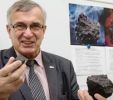Ural scientist joins Nature?s 2013 Top 10 of global world-changing researchers
 Viktor Grokhovsky, a researcher at Ural Federal University, has joined the 2013 Top Ten of people who have changed the world?the only Russian to be named among the best in this years? ranking by Nature Journal
Viktor Grokhovsky, a researcher at Ural Federal University, has joined the 2013 Top Ten of people who have changed the world?the only Russian to be named among the best in this years? ranking by Nature JournalViktor Grokhovsky, an associate professor of Yekaterinburg-based Ural Federal University (UrFU) and member of the Russian Academy of Sciences committee for meteorite study, has joined the 2013 Top Ten of people who have changed the world?the only Russian researcher to be named among the best in this years? ranking by Nature, an influential international scientific journal, the UrFU press service announced. Mr. Grokhovsky became globally renowned this past February with his study of the structure and physical-chemical properties of the ?Chelyabinsk? meteorite?the one that fell into Lake Chebarkul in the neighboring Chelyabinsk region on February 15, 2013, following the cleavage of an asteroid in the terrestrial atmosphere and causing a series of atmospheric explosions that brought about wreckage in several surrounding regions. The Yekaterinburg scientist also personally participated in hoisting the largest fragment of the meteorite from the bottom of the lake in late February. Applying special methods of optical and electronic microscopy at Nanomaterials & Nanotechnology, a UrFU scientific and educational center, the Grokhovsky-led research team found an unusual diversity of inclusions with nickel-containing iron, sulfides and native copper in the meteorite...
Похожее
Ural scientists develop magnetometer for Kazakhstan nanosatellite
Ural scientists team up with MIT in new photonic and electronic material research
Brand new chemical compound for cardiovascular therapy created in Urals
The projects of Technopolis of UrFU received support of Federal Government
Urals? science and business team up; Moscow co-funds projects
Ural scientists to create state-of-the-art air sounding for Russia?s new space center